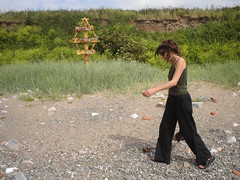Thursday, March 8, 2007
Only in silence the word... (Ursula K. LeGuin)
What is poetry? and what is it for?
At its most basic, poetry is made up of units of language, ordered in a certain way. We all use language, in one form or another, every day. It is a functional currency. In its most common form, it is a means we have adapted to communicate our basic physical needs – from indicating we want to use the toilet, to sending an email to a colleague. Language becomes exhausted, overused. We forget to listen closely to the sounds of its composition, its versatility and creativeness. Poetry then, refreshes our senses to language and encourages us to play with the different ways it can be used.
Poetry is a musical composition. We listen to music to uplift our spirits, to aid reflection, to remind ourselves of a time gone by, to release energy or an emotion…yet we tend to overlook poetry, even though a poem does the same thing. The process of composing a poem involves the same consideration as composing a piece of music. The poet searches for the right word, the best sound, the most evocative rhythm to express the meaning held within the poem. We experience a poem twofold – receiving simultaneously the meaning of the words and the construction of the language. If the poet has done it well, we will not be aware of the construction, but instead receive it as part of the meaning – and in this way, a poem becomes something that is understood both intellectually, and physically.
In this world, the word is both functional and expressive. Poetry digs deeper in order to discover the base note held in language. At its base line, language is made from sound and silence, and poetry becomes a composition of breath, sound and silence. Silence is a prerequisite for the voice, a space for it to invest, a resonance chamber in which to reverberate. In silence resounds voice, in voice silence is present. Poetry consists in turning the invisible—silence or a voice—into perception and presence.
How then, does language and silence define our world, and us within it? How does the act of naming define our world? How do words take shape? What ‘shape’ are these words? What ‘shape’ is silence?
In my poem, Poem 16, also from Fragile Bodies, I attempt to capture a life changing moment, the moment when the mother is told her pregnancy has failed. Through the use of silence, and space on the page, as well as the sound and meaning of words, I have tried to communicate to the reader the sense of loss and the silence of that moment:
Poem 16
They say:
the structure is growing somewhere else.
They tell me:
the womb is empty.
I look, straining to see
the pinprick heart
that will tell me
you have stayed.
There is nothing;
only space
and water
and longing.
The poem, in this way, becomes a physical, sensory experience, moving language from the purely functional, into the experiential, the expressive. Here there is interplay between functional language, and expressive language.
Subscribe to:
Post Comments (Atom)


1 comment:
There were many unconscious reasons why I took up playing the drums, expressing anger was one of them, but a side effect was that my poetry became more rhythmic as a result. When playing rhythm the spaces between notes are just as important as playing the notes, especially in something like funk. It's hard to put that across on a page of words, easier when I perform. (FUNKY!)
What interested me when I visited Beaumount was that many of the students have their own individual rhythms of speech, much more individual than the population as a whole. It takes a while to adjust to this and to listen properly, you have to really listen to everybody, especially if they rely on inedequate machinery to express their deepest thoughts or they cannot speak as quickly or loudly as they would like.
But it makes them very individual and I thought how wonderful it would be if somehow (and I don't know how!!) their rhythms could be interwoven into a tapestry of words and sounds and colours.
Post a Comment